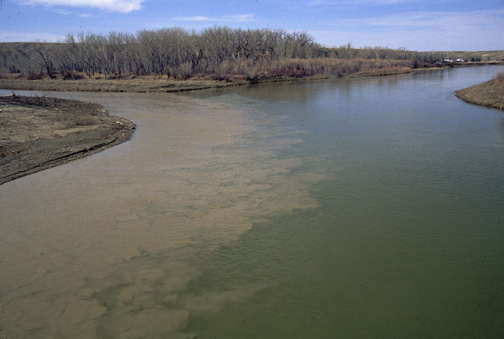As they returned to camp on the morning of their stroll to the heights to view their surroundings (2 June 1805), the captains “boar a little to the left and discovered a handsome little river falling into the N. fork on Lard. side [the west side; their left, looking “Maria’s River”] about 1½ ms. above our camp.” Clark first called it the “Tanzey.” Apparently Lewis dubbed it Rose River, for he noted that “the wild rose which grows here in great abundance in the bottoms of all these rivers is now in full bloom, and adds not a little to the beauty of the cenery.”
We have no clue as to who gave it its present name, Teton, nor when, much less any logical reason for it.
With the name “Tanzey,” Clark referred to a plant he saw in great quantities along this tributary that presumably resembled a familiar one back in Virginia, the common tansy (Tanacetum vulgare L.), a perennial herb that had been introduced into colonial gardens from Europe, probably for medicinal purposes.
The common tansy spreads aggressively by means of short rhizomes, or underground stems, and by its attractiveness to a wide variety of insects for pollination purposes. It is now considered a weed, especially in pastures, since it is unpalatable to cows and horses. It seems highly unlikely, of course, that it could have spread fast enough to have established a presence on the Tansy-Rose-Teton River by 1805. Yet the other members of the sunflower family with which botanists figure Clark might have confused it—pineapple weed and dog fennel—are so obviously different in one aspect or another that we cannot determine what plant he was really remarking upon.
The mainstem of the Teton is free-flowing. Tiber Dam, 78 miles above the confluence shown in the figure, has interrupted the main channel of the Marias River since 1956. Every spring, as high water from upland snowmelt scours its valley, the Teton delivers a huge load of silt for dilution in the Marias.
On the Marias, however, soil from the many square miles of river basin above Tiber Dam is dropped in the slack water of the reservoir, Lake Elwell. The outflow from the dam, prevented from overflowing the riverbanks below, remains comparatively clear all the way to the Teton.
In 1805, the degree of similarity between the color of the “right hand fork”—”Maria’s River”—and the river they had been travelling convinced most of the Corps that it was the better choice than the left fork. Today, with the clear water of the lower Marias only partly muddied by that of the Teton, the choice would appear somewhat more obvious.
Experience the Lewis and Clark Trail
The Lewis and Clark Trail Experience—our sister site at lewisandclark.travel—connects the world to people and places on the Lewis and Clark Trail.
Discover More
- The Lewis and Clark Expedition: Day by Day by Gary E. Moulton (University of Nebraska Press, 2018). The story in prose, 14 May 1804–23 September 1806.
- The Lewis and Clark Journals: An American Epic of Discovery (abridged) by Gary E. Moulton (University of Nebraska Press, 2003). Selected journal excerpts, 14 May 1804–23 September 1806.
- The Lewis and Clark Journals. by Gary E. Moulton (University of Nebraska Press, 1983–2001). The complete story in 13 volumes.


